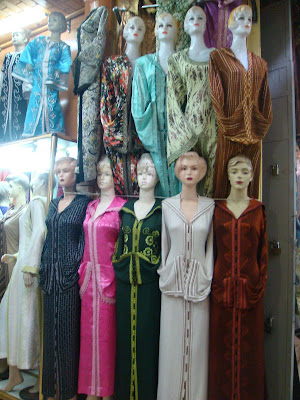


Before I arrived in Casablanca, I had heard that it was not very nice. The city had been described to me as sprawling and industrial, and altogether not what one would expect for the mythologized city that gave us, "Play it again, Sam."
Although people have lived in Casablanca since the 11th century BC, it was never very big. At one point it was a safe haven for pirates, leading the Portuguese to destroy the city. After it was rebuilt, it again was destroyed - this time by an earthquake. As late as 1880, no more than 10,000 people lived in Casablanca. And then, in the early 20th century, the French arrived and developed it into a metropolis.
Charlie and I had decided to skip Casablanca entirely. But then, we took a bus from El Jadida to Meknes and had to spend a few hours in Casablanca while waiting to change buses. So, we had a quick look around. We followed the walking tour described in
Lonely Planet, which snakes through the Nouvelle Ville past some Art Deco buildings, then some large, Arabic-styled government buildings, and to a Roman Catholic church.
When anyone asks me what I have learned from my five-month adventure, I will tell them this: I don't like Art Deco buildings. First in Napier, New Zealand, and now Casablanca, of all places, I have seen and disliked art deco buildings. I like Art Deco art, jewelry and furniture, but (other than a few impressive buildings I recall liking in New York City) Art Deco buildings - particularly, lots of art Art Deco buildings all together - leave me cold.
As Charlie and I followed the walking tour past Casablanca's art deco buildings, and as
Lonely Planet enthused about them, I couldn't help but think that they were trying to look a little like buildings in Paris, but they weren't as pretty or clean. I registered my dissatisfaction with Casablanca's art deco buildings by refusing to take any pictures of them. (If you want to see pictures, you can ask to see some of Charlie's; he seemed to like them.)
The Catholic church in Casablanca, on the other hand, was beautiful. The stained glass in the rose window was absolutely stunning. My camera did not adequately capture the radiance of the colors, which shined like jewels.
Usually, the church is not open because there are not many Catholics left in this area of the world. But, we were in luck; the building is being used for an upcoming art exhibition and there were people inside setting up. We were able to climb to the very top of the bell tower, passing about 100 pounds of pigeon guano along the way, and look out over the whole city. This was an unexpected treat and the one thing I can strongly recommend doing in Casablanca.




















































